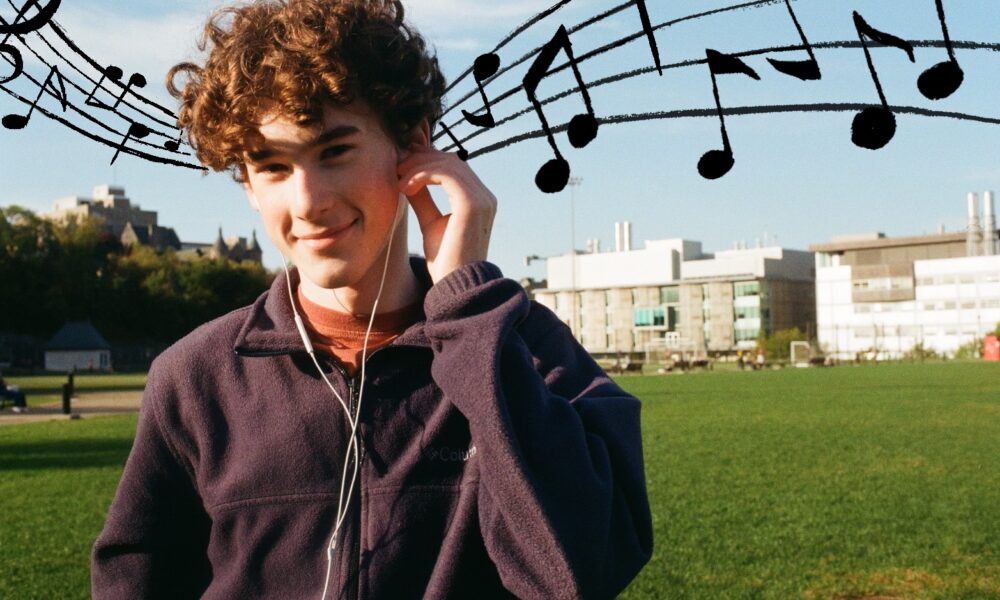Imagine strolling through the bustling streets of downtown Montreal, where the air is thick with the rumble of traffic and the screeching of construction. It’s not exactly the most relaxing experience, is it? Could urban planners transform these soundscapes into something more pleasant?
Valérian Fraisse, a PhD student in Music Technology at McGill, is devoted to applying science to music. His research focuses on urban soundscapes—the overlapping environmental sounds that make up our auditory experiences in urban settings—by investigating how to improve environments through sound installations and perceptive evaluations.
In a recent study, Fraisse and colleagues from the Sounds in the City research partnership, led by Professor Catherine Guastavino, explored the transformation of Fleurs-de-Macadam Square. This community space, created from a vacant lot in the Plateau-Mont-Royal, became the site for sound installations designed by the artist collective Audiotopie. Over two summers, sound artists from Audiotopie created and installed four sound pieces: Woodland sounds, voices, synthesizers, and sounds of the sea.
“Sound artists play an important role in contributing to providing better sound experiments, especially because they are experts in what they do […] they are sonic experts that know what kind of sound could be done to improve or alter the perception of a given space,” Fraisse said in an interview with The Tribune.
While using sound to mask unwanted noise isn’t new, the study reveals these installations can do more than just cover up unpleasant sounds. Through the analysis of over 800 questionnaires and sound level measurements, the researchers found that all four sound installations positively impacted people’s perception of the soundscapes.
Key findings showed that despite their compositional differences, the sound pieces all contributed to a calmer soundscape. This universal impact suggests that installations that utilize peaceful sounds enhance the tranquillity of public spaces.
However, specially tailored compositions can go beyond making an environment calmer, and actually achieve specific desired effects. For instance, the woodlands installation, which incorporated natural sounds, increased the sense of “being away” from the business of the city. On the other hand, the synthesizer installation, using abstract sounds, created a more coherent and less chaotic soundscape, highlighting how different sonic approaches achieve distinct perceptual outcomes.
“I would say also that the goal of this installation is never to strongly alter the sound environment,” Fraisse explained. “So it’s a very subtle kind of ambient sound. The goal is for it to be nondisruptive, so it can bring a more pleasant atmosphere without deterring people from staying there.”
The sound installations went beyond masking unwanted noise; they promoted “attentional masking” by shifting listeners’ focus to less prominent sounds in the environment. For example, instead of being overwhelmed by traffic noise, listeners become more aware of the quieter nearby construction. The installations effectively helped people tune into the quieter elements of the environment.
The research also highlights the significance of temporal and spatial variables. A sound installation’s effect can vary depending on the time of day and where people are within the space. Further research is needed to explore these implications and the long-term considerations, such as habituation and changing community needs.
Fraisse believes that sound installations offer a valuable tool for public urban planners seeking to improve public spaces.
“In [urban] areas that don’t have a lot of variety, for instance, that are pretty dominated by traffic or noises that are not specifically restorative or interesting, [sound installations] can play a great role by bringing sonic diversity, but also just fostering cultural and social interactions, so there can be many benefits,” Fraisse said.
In addition to these advantages, the installations are relatively inexpensive, adaptable to various spaces, and versatile in the types of sound content they can incorporate. By adding soundscapes to the urban planning toolkit, they offer a creative and effective way to enhance the enjoyment and restoration of urban environments.
The study contributes to growing research on the importance of sound in our urban experience. As cities become increasingly noisy, creating oases of calm and tranquillity is essential. In the grand orchestra of urban living, soundscapes can be the key to making a city sing—not just shout. This project is part of the Sound in the City team’s ongoing inquiry, aimed at bridging research and practice to develop improved approaches for urban noise management and soundscapes in Montreal.









